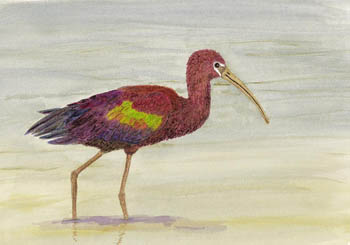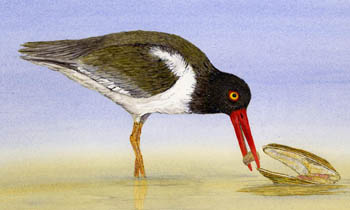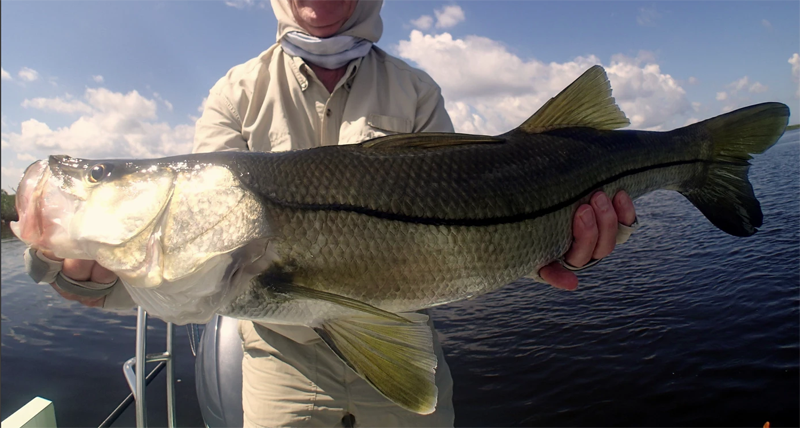
Beach snook and the Snook Foundation. Six Atlantic and six Pacific Ocean species are currently recognized as scientifically valid. All Robalo or snook species are capable of inhabiting both fresh and saltwater and are known to seasonally occupy Gatun Lake, which forms a water bridge connecting the Atlantic and Pacific Oceans as an integral part of the Panama Canal. Of the twelve species only 4 are known to reach sizes in excess of 10 lbs. – two Atlantic Ocean species (Centropomus undecimalis and Centropomus poeyi) and two Pacific Ocean species (Centropomus viridis and Centropomus nigrescens). Source Wikipedia. Photo credit Capt. Mark Giacobba.
The common snook and Don Reed’s Destroyer
By Skip Clement – Shore Bird Illustrations by Thom Glace
The common snook [Centropomus undecimalis] occurs from South Carolina to Brazil, including Florida to Texas along the Gulf of Mexico, Cuba, Puerto Rico, and the Cayman Islands. The Pacific version, [Centropomus spp.]

Glossy Ibis – Illustration by Thom Glace. Shore birds are a bonus of fishing the beaches.
However, they are generally found in southern Florida, from about Cape Canaveral on the Atlantic coast, around the peninsula, to about Tarpon Springs on the gulf coast. The distribution then becomes disjunct, and they are again found from southwest Texas, south along central and south America, to Rio de Janeiro, Brazil.
The post snook spawn in Florida triggers some of its best beach fly fishing
The common snook is the largest and most common of the five species and is the species caught by most anglers. In Florida waters, undecimalis may grow to 48-inches and 38-pounds. The IGFA world records are:
All-Tackle common snook [Centropomus undecimalis]: 53 lb 10 oz / Parismina Ranch, Costa Rica / 1978
Pacific-Centropomus spp.: 58 lb 9 oz / Rio Bayano, Panama / 2012
Tippet Class common snook [Centropomus undecimalis]: 30 lb 4 oz / 20# tippet / Chokoloskee, Florida / 1993
Pacific-Centropomus spp.: 22 lb / 12# tippet / Cabo San Lucas, Mexico / 2004

Red Knot – Illustration by Thom Glace. Shore birds are a bonus of fishing the beaches.
Adult Snook
Male snook may reach sexual maturity at one year, typically by two to three years. Female maturity is around three to four years. The probability that common snook of a particular size will be female increases with length and age. On the west coast of Florida, at age five, there’s about a 50% mix of males to females. However, most male snook transition to female, but not all will. In Florida, the oldest female recorded was 15 years on the Gulf coast and 18 years on the Atlantic coast. The oldest male was 12 years on the Gulf coast and 15 years on the Atlantic coast. Although the oldest snook recorded was 18 years, it’s thought they can live at least 20 years and probably closer to 30 years. — IGFA
Diet
Seventy percent of an adult snook’s diet consists of fish with pinfish (20%) and minnows (16%) rounding out the top two positions for prey items, followed by shrimp at 13%. Snook eat greater than ten times more pinfish in the summer months than in the winter even though more pinfish are available to them in the winter. This is likely because pinfish recruit to the estuary in the winter and are very small. Studies have shown that snook prefer prey 14% their own body length, so in the winter months, pinfish are much too small to be attractive to an adult snook. Snook feed on shrimp year-round but more so in the winter.
During winter months, snook stomachs contain only about a quarter of what is in them in the summer. This is likely because cold water causes their metabolic rate to slow, resulting in decreased feeding. In fact, snook are extremely cold sensitive and become lethargic and may die when water temperatures dip below 60 degrees for any length of time. — Betty Staugler, University of South Florida

Oyster Catcher – Illustration by Thom Glace. Shore birds are a bonus of fishing the beaches.
Fly fishing the beaches of South Florida’s coasts offers solace and great post spawn snook action because the fish are hungry and the snowbirds are still in New Jersey. Note: Everglades National Park has it offering but no real beach to match the Gulf of Mexico or the Atlantic Ocean.
Because of wind coming off the water, although usually still at dawn and dusk if no weather front is in play, it’s making mine a nine [9-weight] for surfing for snook. There are several tried and true fly patterns to go with, but today here’s a version of the 40 Snook Fly as tied by Don Reed of St. Augustine, Florida.
Note: Featured Image provided courtesy of Capt. Mark Giacobba . . .


